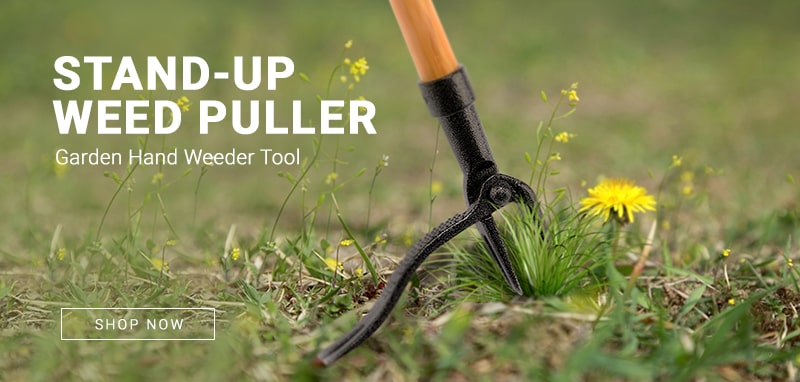While weeds are often perceived as invasive plants, these are nature’s way of protecting the soil from erosion, forest fire, and other natural disasters. Weeds are native vegetation that reclaims the soil to add a layer of protection from the elements.
Of course, if you’re a gardener, you know weeds tend to compete with crops for soil nutrients. Some weeds are also toxic to small children and pets, while others are known to cause skin and pollen allergies.
Why is proper identification important in weed control? Different weeds react to various deterrents. Some deterrents may work for crab weeds but not in dandelions. By identifying the types of weed, you’ll know exactly how to get rid of them for good.
Contents []
5 Common Types of Weeds In The Garden
In this guide, we outline the top 5 common weeds that grow in the garden:
Crab Grass
Crabgrass is the most common and most despised garden weed. Besides being prolific growers, crabgrass can produce up to 200,000 seeds, many of which can survive in the soil before sprouting to wreak havoc above ground. This annual plant develops roots at stem nodes, so crabgrass grows exceedingly fast.
Unfortunately, killing crabgrass with common herbicides might damage lawn grass, so to get rid of it, you need to pull each one from the ground. When removing the weeds by hand, check if you’ve pulled the entire root system to prevent regrowth. Invest in a good weeder if you have a lot of crabgrass in your garden.

Yellow Wood Sorrel
Yellowwood sorrel is another prolific grower that can take over a garden quickly if left unchecked. The reason for its uncanny ability to spread quickly is each sorrel can produce tens of thousands of seeds, and they’re all self-propagating. The seeds spread everywhere and stick to just about any surface to spread further – including clothing, pets, and uncleaned garden tools.
The best way to eliminate yellowwood sorrel is to pull the weed the second you see one sprout in your garden. Removing its roots completely may discourage new growth. If you’re seeing this weed multiply quickly on your property, know that all parts of the plant are edible – including the leaves and flowers. Yellow wood sorrel has a bright, tangy flavor and is often added to salads.
Common Ragweed
This annual plant grows in empty patches of land, yards, road edges, and open fields. What makes ragweed so despised by homeowners and gardeners alike is its hyper-pollen production, which causes hay fever. During its flowering season, the plant releases innumerable pollen that spreads on most surfaces, causing misery to so many people.
To get rid of ragweed, you must block sunlight and prevent the seeds from germinating. As soon as you see a patch of ragweed growing in your garden, cover it with landscape fabric with mulching. You may need several rolls of landscape fabric covering a vast land area. Use high-quality landscape fabric so you won’t change often but make sure the material is porous so water and nutrients can seep into the soil for crops to grow.
Lambsquarters
This annual weed is one of the most commonly found worldwide. That’s proof of its resilience. Besides being highly adaptable, it’s also quick to spread all over the place. Each plant can release tens of thousands of seeds in a single season. While attractive with its delicate silvery-purple leaves, it is nutrient-hungry and will compete with all crops for food and space.
The good news is, there are many ways to eliminate lambsquarters! You can use chemical or non-chemical herbicides to kill lambsquarters. You can also pull each one by hand and harvest them as herbs. Use lambsquarters to season sauteed and stir-fries with it. Lambsquarters are a part of the spinach family, so these are perfectly safe to eat. Add it to raw salads; they’re pretty tasty!
Plantain
Rounding up our list of the five common weeds that grow in your garden is the common plantain. This invasive plant is a broadleaf perennial that grows in clumps. If left unchecked, plantain will quickly spread in broad clusters and crowd out crops in the garden.
Plantain propagates by dispersing seeds through their flowers. And these seeds can contaminate any surface they land on, including mower blades, shoes, pets, other grass, etc. The seeds stick to anything that moves to spread more of it all over. Once these seeds are released, they quickly sprout and take over entire lands. Plantain is quite stubborn, too, thanks to its sturdy tap roots. Using a weeder and pulling plantain one by one is the best strategy for keeping your garden free from these pesky weeds.
ECOgardener Landscape Fabric for Weed Control

While weeds are quite stubborn and hard to eliminate completely, they share one weakness: they need sunlight to grow. By blocking out the sun, the seeds won’t germinate. Using landscape fabric and mulching are, by far, the best way to deal with weeds of all kinds naturally. For small gardens, invest in an excellent weeder to clear your space of occasional weeds!



